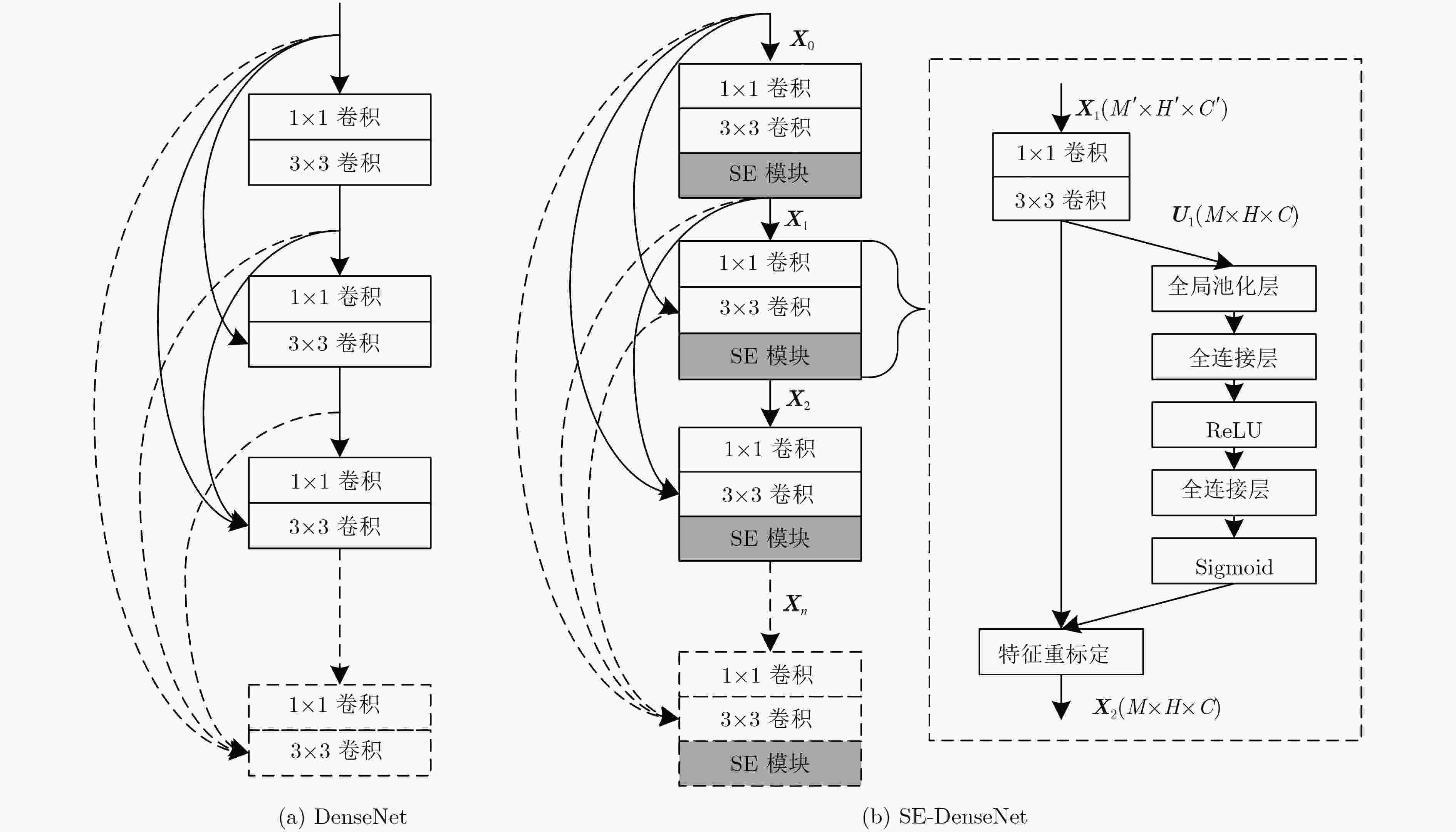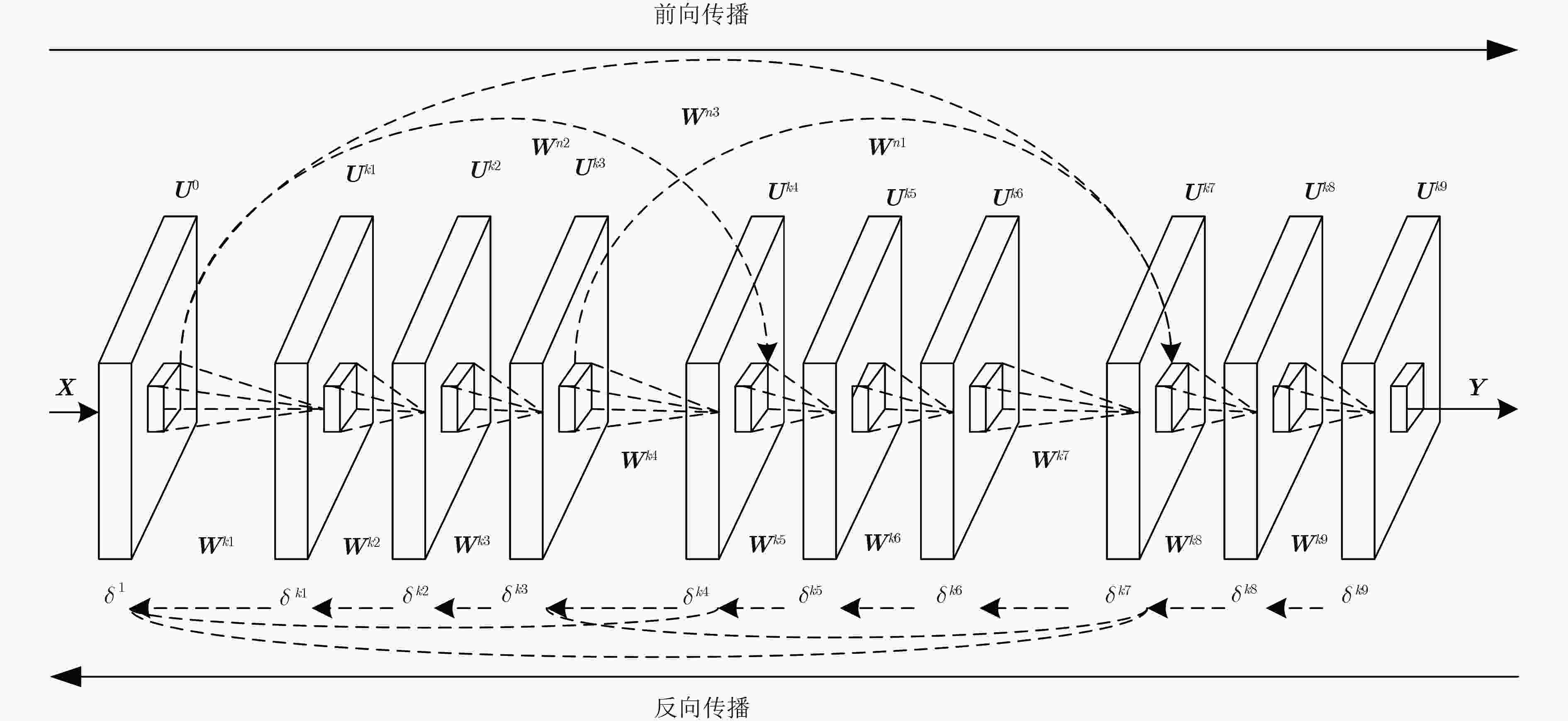Flight Delay Prediction Model Based on Deep SE-DenseNet
-
摘要: 针对目前民航运输业对航班延误高精度预测的需求,该文提出一种基于深度SE-DenseNet的航班延误预测模型。该模型首先将航班信息、相关机场延误信息和天气信息进行数据融合;其次,利用改进后的SE-DenseNet算法对融合后的航班数据集进行自动特征提取;最后,构建Softmax分类器进行航班离港延误等级的预测。该文提出的SE-DenseNet结构融合了DenseNet和SENet二者的优势,既能加强深层信息的传递,避免梯度消失,又可以实现特征提取过程中的特征重标定。实验结果表明,数据融合后,预测准确率较只考虑航班属性提高约1.8%;算法改进后可以有效提升网络性能,模型最终准确率达93.19%。
-
关键词:
- 航班延误预测 /
- SE-DenseNet /
- 数据融合 /
- 特征重标定
Abstract: Nowadays, the civil aviation industry has a high-precision prediction demand of flight delays, thus a flight delay prediction model based on the deep SE-DenseNet is proposed. Firstly, flight data, associated airport delay information and meteorological data are fused in the model. Then, the improved SE-DenseNet algorithm is used to extract feature automatically based on the fused flight data set. Finally, the softmax classifier is used to predict the delay level of flight. The proposed SE-DenseNet, combing the advantages of DenseNet and SENet, can not only enhance the transmission of deep information, avoid the problem of vanishing gradients, but also achieve feature recalibration by the feature extraction process. The results indicate that after data fusion, the accuracy of the model is improved 1.8% than only considering the characteristics of the flight itself. The improved algorithm can effectively improve the network performance. The final accuracy of the model reaches 93.19%.-
Key words:
- Flight delay prediction /
- SE-DenseNet /
- Data fusion /
- Feature recalibration
-
表 1 SE-DenseNet网络配置信息表
网络层 SE-DenseNet DenseNet 矩阵维度 结构配置 矩阵维度 结构配置 卷积层 $n \times n$ $\left[ {3 \times 3,2k} \right]$ $n \times n$ $\left[ {3 \times 3,2k} \right]$ 池化层 ${n / 2} \times {n / 2}$ $3 \times 3$最大池化 结构块1 $n \times n$ $\left[ \begin{array}{l}1 \times 1,4k\\3 \times 3,k\\{\rm SE}\left( {k/\gamma ,k} \right)\end{array} \right] \!\times\! 6$ ${n / 2} \times {n / 2}$ $\left[ \begin{array}{l}1 \times 1,4k\\3 \times 3,k\end{array} \right] \times 6$ 转换层1 $n \times n$ $\left[ {1 \times 1,0.5k} \right]$ ${n / 2} \times {n / 2}$ $\left[ {1 \times 1,0.5k} \right]$ ${n / 4} \times {n / 4}$ $2 \times 2$平均池化 $ \vdots $ 分类层 $1 \times 1$ 全局平均池化,全连接,softmax 表 2 航班延误等级划分
延误等级 延误时间T (min) 0 (未延误) $T \le 15$ 1 (低度延误) $15 < T \le 60$ 2 (中度延误) $60 < T \le 120$ 3 (高度延误) $120 < T \le 240$ 4 (重度延误) $T > 240$ 表 3 维度变换比率
$\text{γ}$ 对分类性能的影响比率$\gamma $ 准确率(%) 模型大小(MB) 4 93.05 15.46 8 93.15 15.41 12 93.14 15.39 24 93.06 15.36 表 4 算法改进前后模型参数对比
网络层数 DenseNet SE-DenseNet 参数增长比率(%) 22 1608469 1614256 0.36 40 3978167 3989741 0.29 58 7116085 7133446 0.24 表 6 深层SE-DenseNet准确率
网络层数 SE-DenseNet(%) 88 93.19 100 93.17 124 93.19 表 5 算法改进前后分类准确率对比(%)
网络层数 DenseNet SE-DenseNet 16 91.86 92.33 22 92.07 92.69 34 92.28 92.80 40 92.57 93.14 52 92.69 93.17 58 92.72 93.19 表 7 不同影响因素预测准确率对比(%)
网络层数 数据集FO 数据集W 数据集F 16 90.64 92.06 92.33 22 90.96 92.15 92.69 34 91.06 92.29 92.80 40 91.09 92.33 93.14 52 91.24 92.35 93.17 58 91.36 92.38 93.19 表 8 不同预测模型结果对比(%)
模型算法 预测准确率 C4.5决策树 78.05 支持向量机 80.00 人工神经网络 86.30 SE-DenseNet 93.19 -
BASPINAR B, URE N K, KOYUNCU E, et al. Analysis of delay characteristics of European air traffic through a data-driven airport-centric queuing network model[J]. IFAC-PapersOnLine, 2016, 49(3): 359–364. doi: 10.1016/j.ifacol.2016.07.060 KHANMOHAMMAD S, TUTUN S, and KUCUK Y. A new multilevel input layer artificial neural network for predicting flight delays at JFK airport[C]. Complex Adaptive Systems, Los Angeles, USA, 2016: 237–244. 程华, 李艳梅, 罗谦, 等. 基于C4.5决策树方法的到港航班延误预测问题研究[J]. 系统工程理论与实践, 2014, 34(S1): 239–247. doi: 10.12011/1000-6788(2014)s1-239CHENG Hua, LI Yanmei, LUO Qian, et al. Study on flight delay with C4.5 decision tree based prediction method[J]. System Engineering – Theory &Practice, 2014, 34(S1): 239–247. doi: 10.12011/1000-6788(2014)s1-239 徐涛, 丁建立, 顾彬, 等. 基于增量式排列支持向量机的机场航班延误预警[J]. 航空学报, 2009, 30(7): 1256–1263. doi: 10.3321/j.issn:1000-6893.2009.07.014XU Tao, DING Jianli, GU Bin, et al. Forecast warning level of flight delays based on incremental ranking support vector machine[J]. Acta Aeronautica et Astronautica Sinica, 2009, 30(7): 1256–1263. doi: 10.3321/j.issn:1000-6893.2009.07.014 MANNA S, BISWAS S, KUNDU R, et al. A statistical approach to predict flight delay using gradient boosted decision tree[C]. 2017 International Conference on Computational Intelligence in Data Science, Chennai, India, 2017: 1–5. KIM Y J, CHOI S, BRICENO S, et al. A deep learning approach to flight delay prediction[C]. 35th Digital Avionics Systems Conference, Sacramento, USA, 2016: 1–6. LECUN Y, BENGIO Y, and HINTON G E. Deep learning[J]. Nature, 2015, 521(7553): 436–444. doi: 10.1038/nature14539 HUANG Gao, LIU Zhuang, and WEINBERGER K Q. Densely connected convolutional networks[C]. 30th IEEE Conference on Computer Vision and Pattern Recognition, CVPR 2017, Honolulu, USA, 2017: 2261–2269. HU Jie, SHEN Li, and SUN Gang. Squeeze-and-excitation networks[OL]. https://arxiv.org/pdf/1709.01507.pdf, 2018.4. IOFFE S and SZEGEDY C. Batch normalization: Accelerating deep network training by reducing internal covariate shift[C]. 32nd International Conference on Machine Learning, Lile, France, 2015: 448–456. NAIR V and HINTON G E. Rectified linear units improve restricted boltzmann machines[C]. 27th International Conference on Machine Learning, Haifa, Israel, 2010: 807–814. RUMELHART D E, HINTON G E, and WILLIAMS R J. Learning representations by back-propagating errors[J]. Nature, 1986, 323(9): 533–536. doi: 10.1038/323533a0 DUAN Kaibo, KEERTHI S S, CHU Wei, et al. Multi-category classification by soft-max combination of binary classifiers[C]. 4th International Workshop on Multiple Classifier Systems, Guildford, United Kingdom, 2003: 125–134. SHEN Li, LIN Zhouchen, and HUANG Qingming. Relay backpropagation for effective learning of deep convolutional neural networks[C]. European Conference on Computer Vision, Amsterdam, The Netherlands, 2016, 467–482. doi: https://doi.org/10.1007/978-3-319-46478-7_29. HE Kaiming, ZHANG Xiangyu, REN Shaoqing, et al. Delving deep into rectifiers: Surpassing human-level performance on imagenet classification[C]. 15th IEEE International Conference on Computer Vision, Santiago, Chile, 2015: 1026–1034. 吴仁彪, 李佳怡, 屈景怡. 基于双通道卷积神经网络的航班延误预测模型[J]. 计算机应用, 2018, 38(7): 2100–2106. doi: 10.11772/j.issn.1001-9081.2018010037WU Renbiao, LI Jiayi, and QU Jingyi. Flight delay prediction based on dual-channel convolutional neural networks[J]. Journal of Computer Applications, 2018, 38(7): 2100–2106. doi: 10.11772/j.issn.1001-9081.2018010037 -






 下载:
下载:







 下载:
下载:
